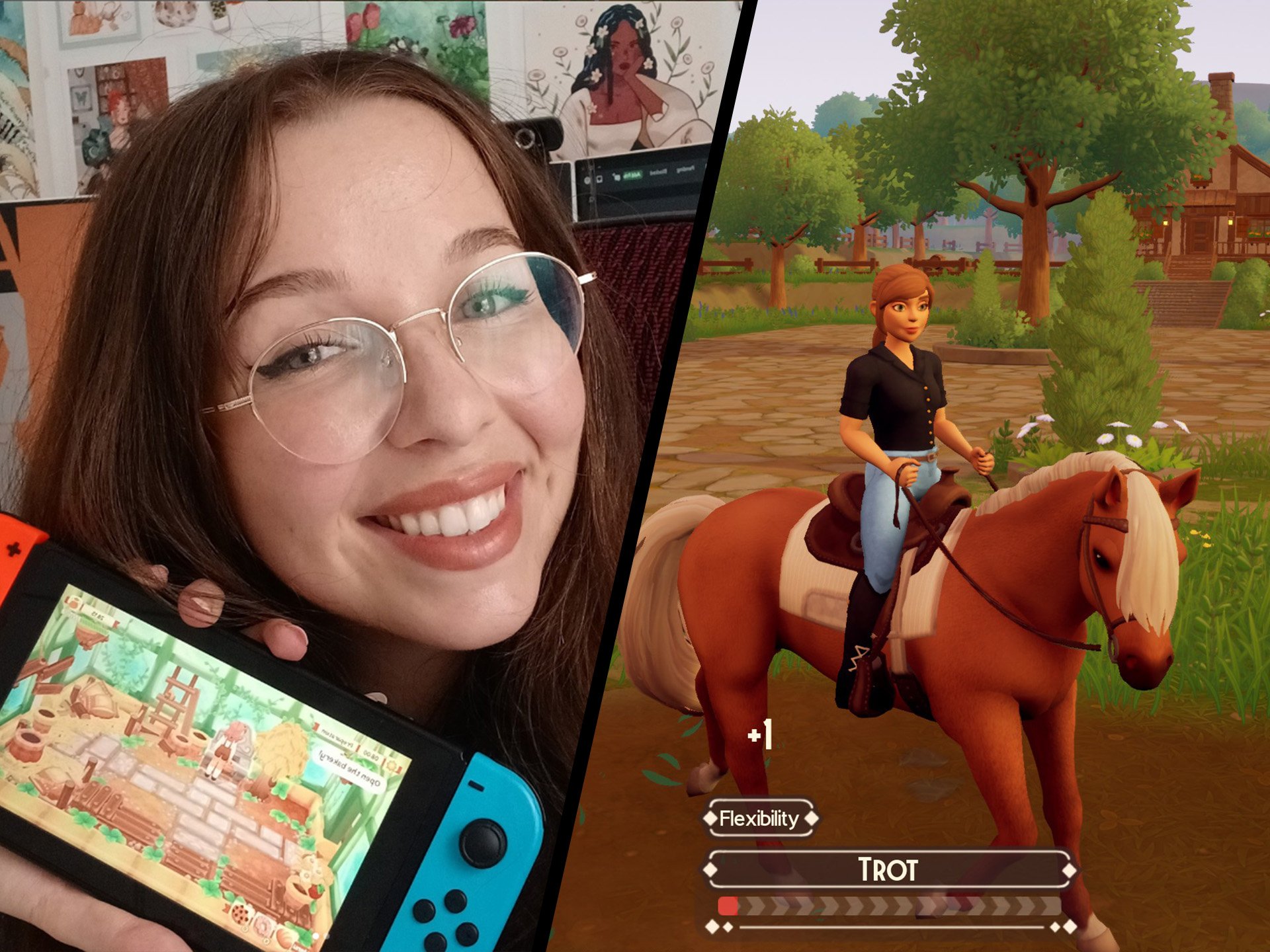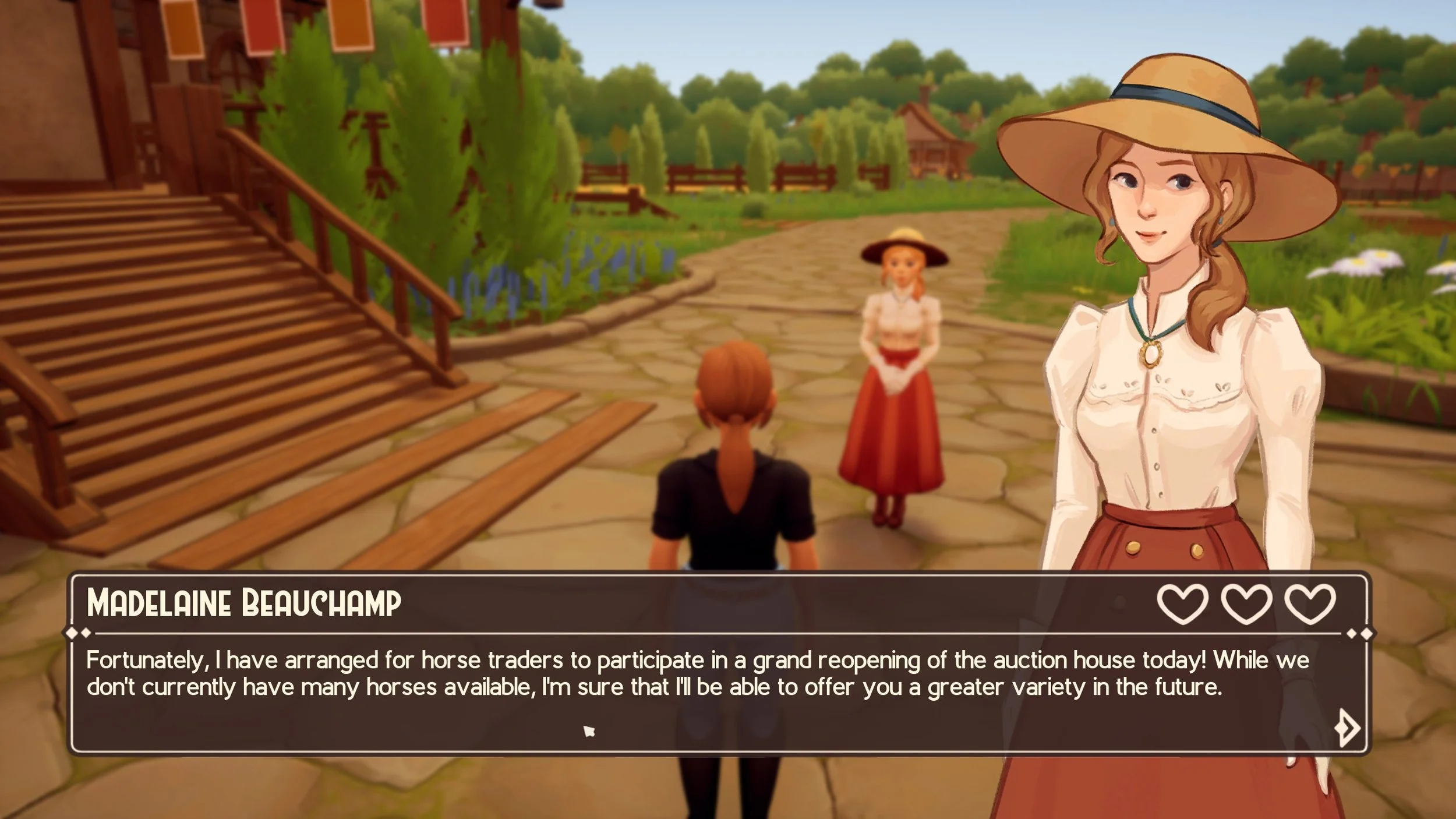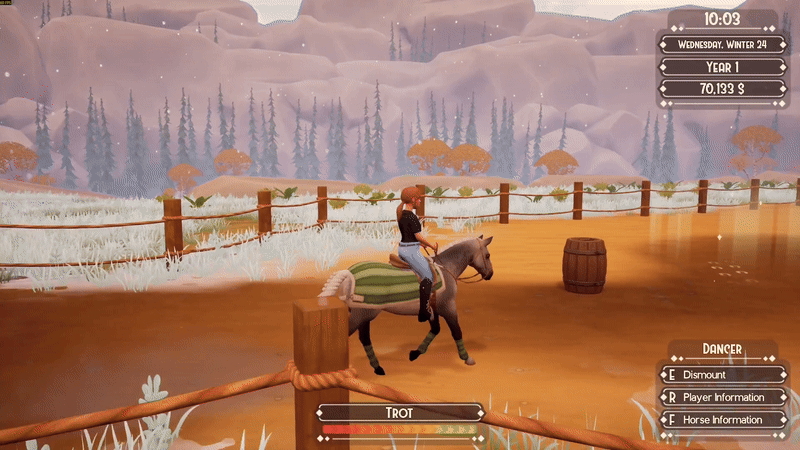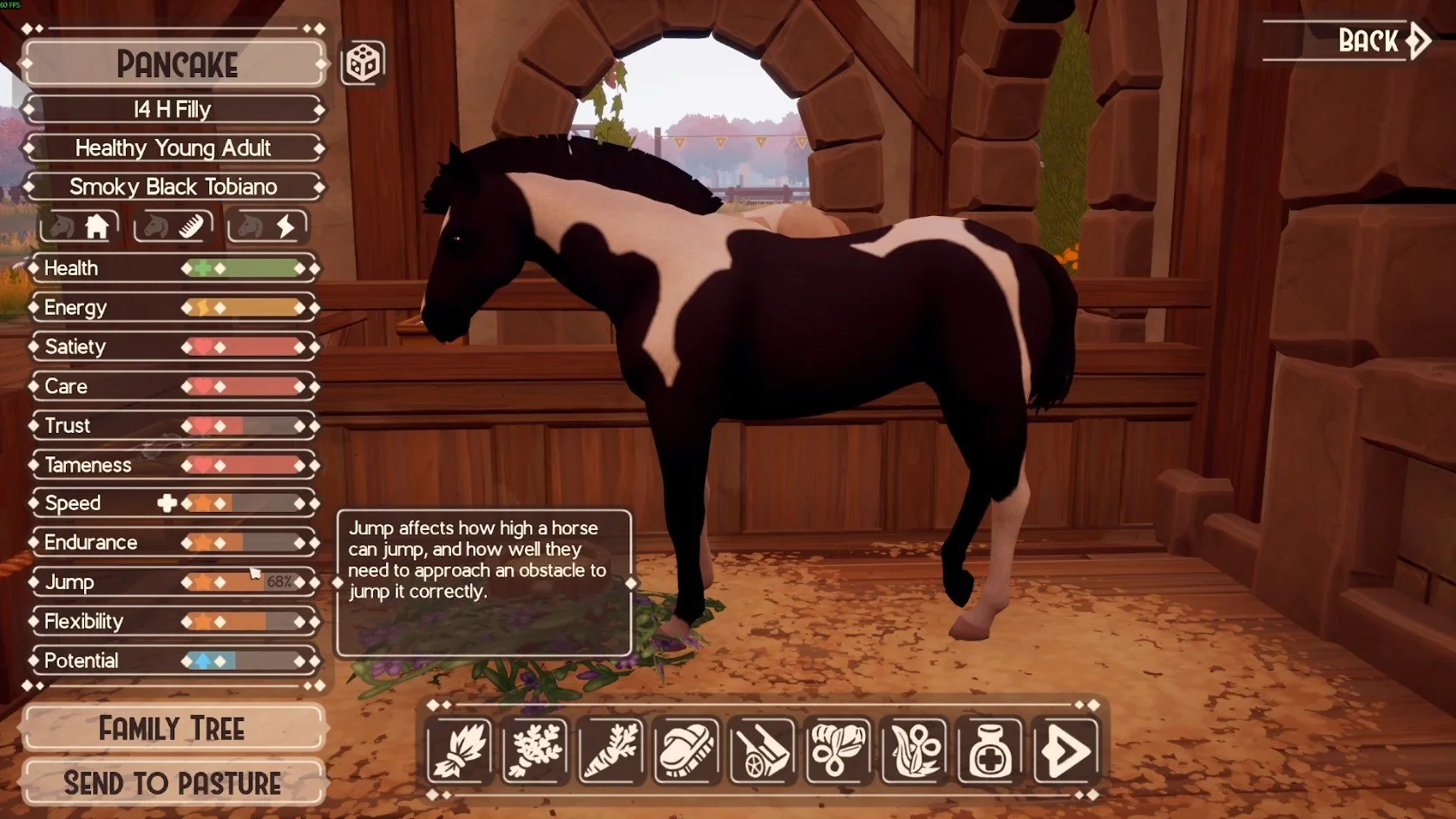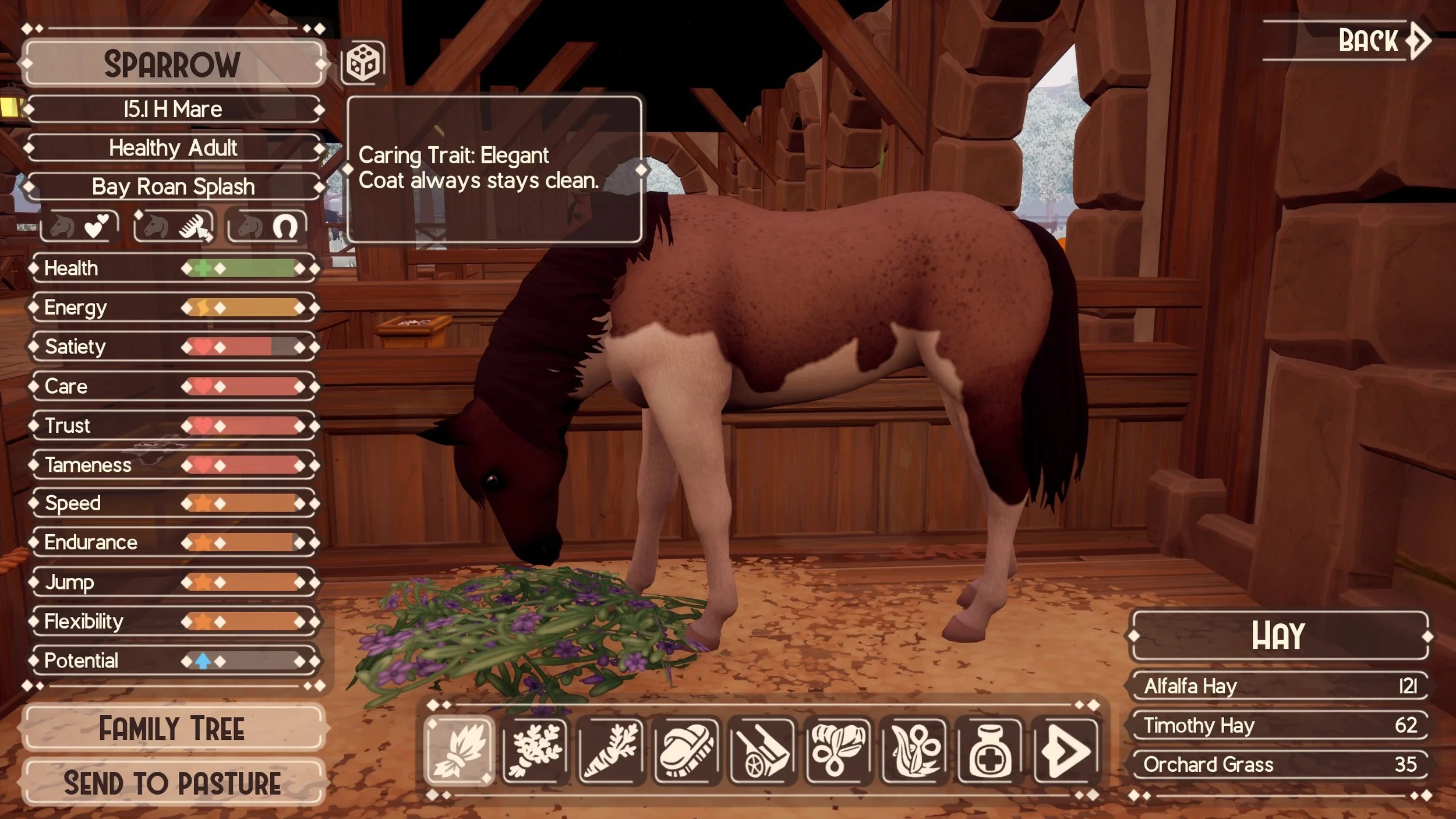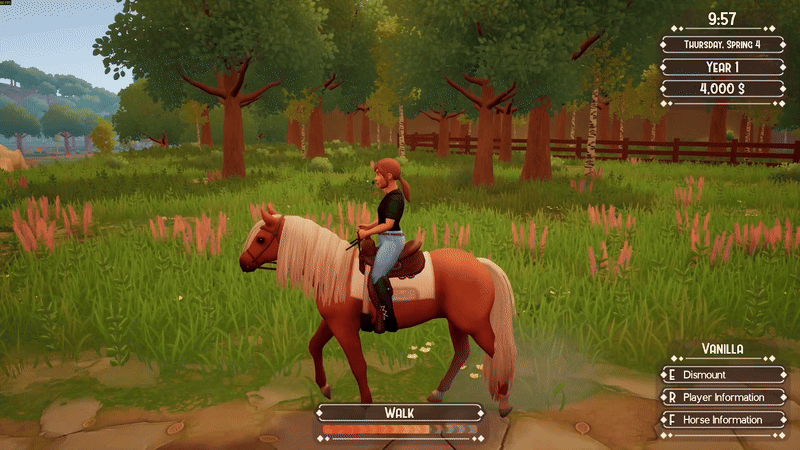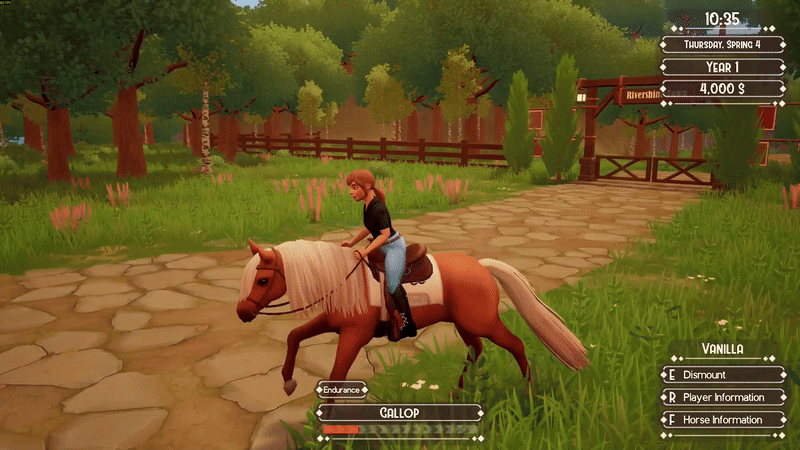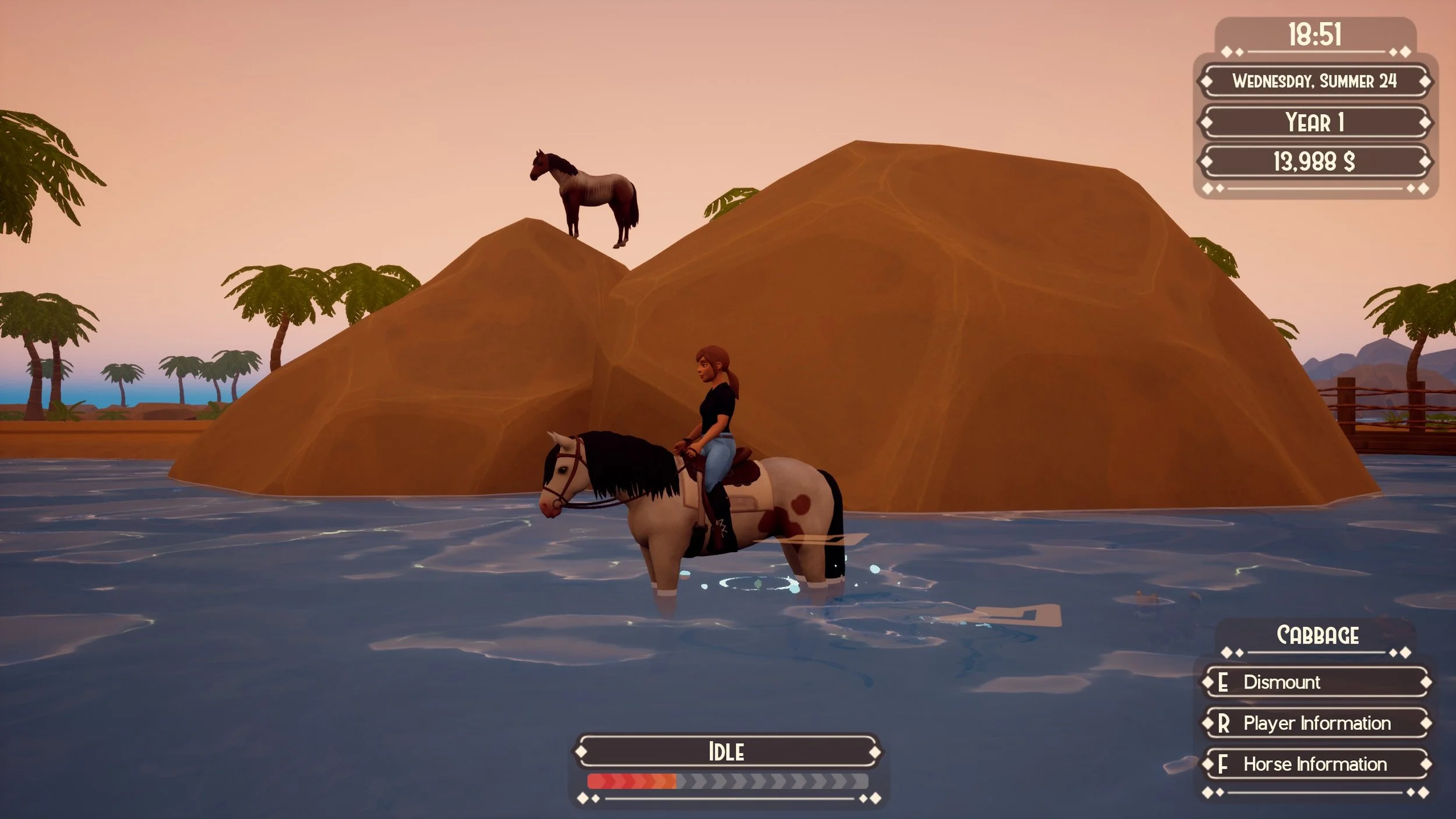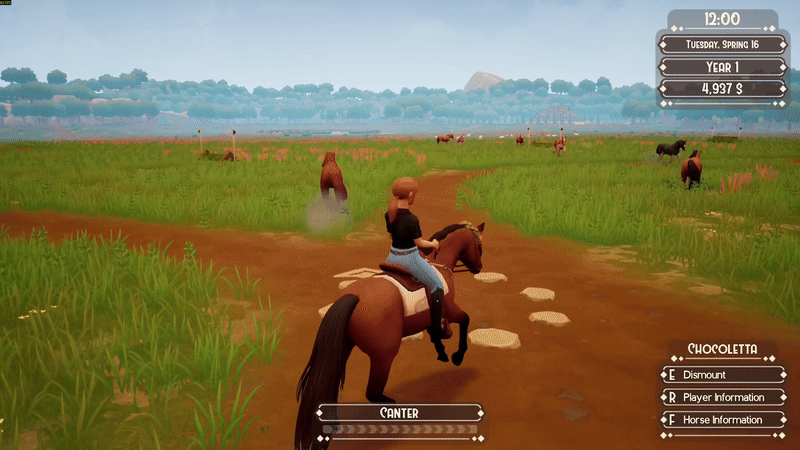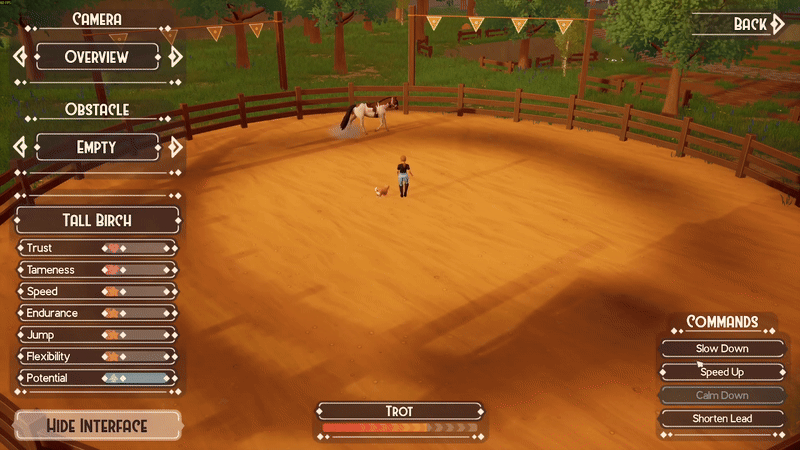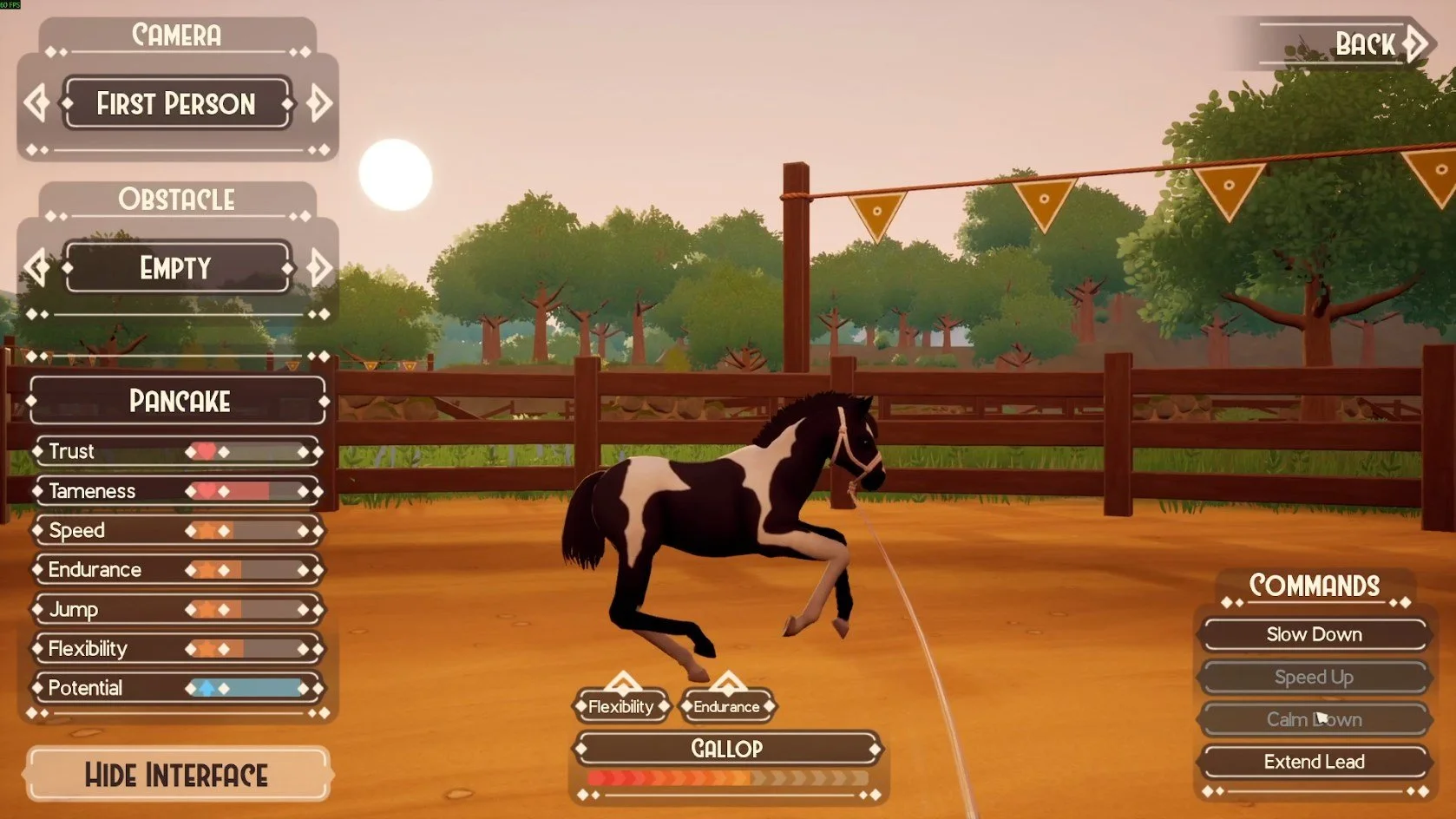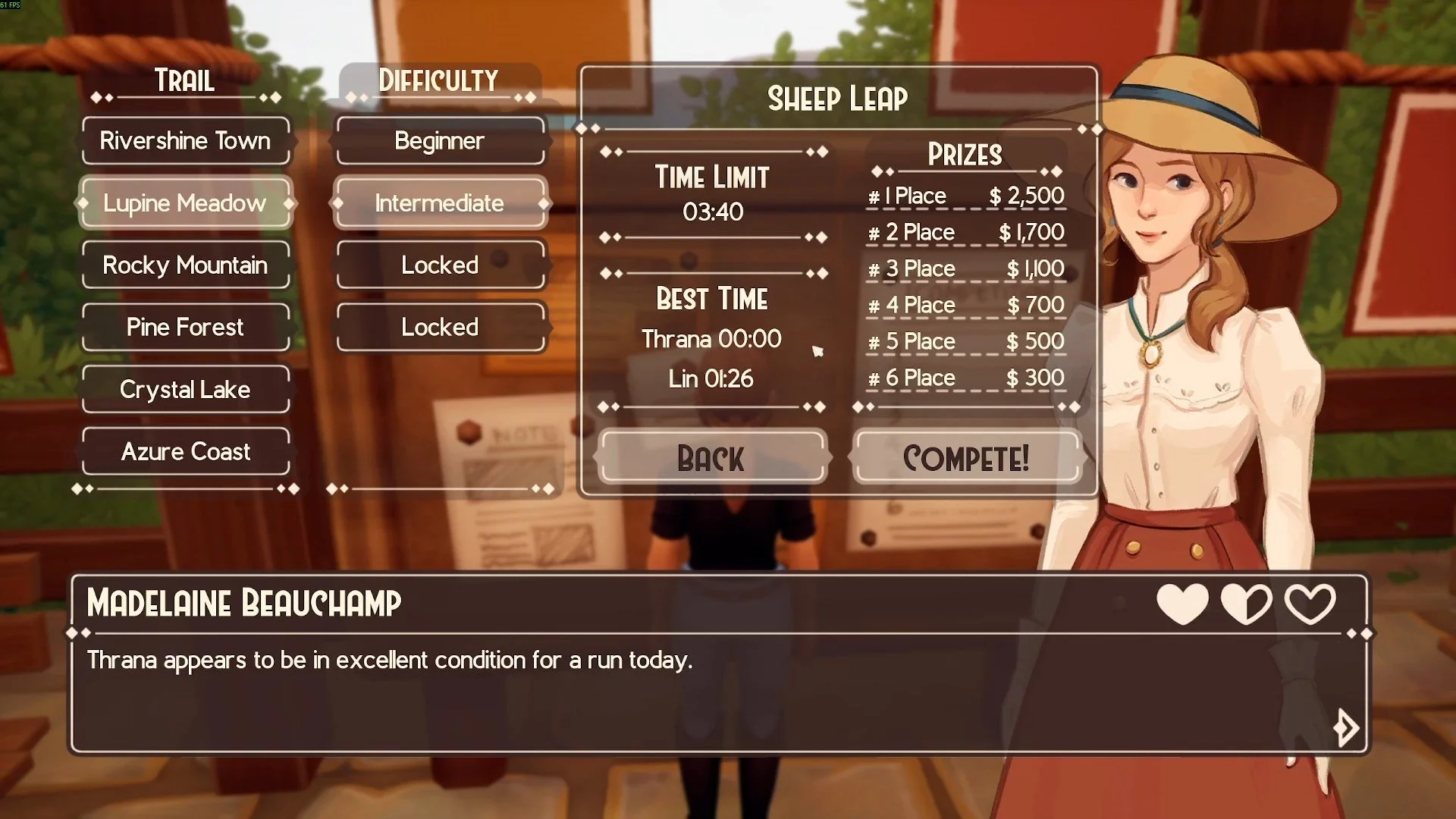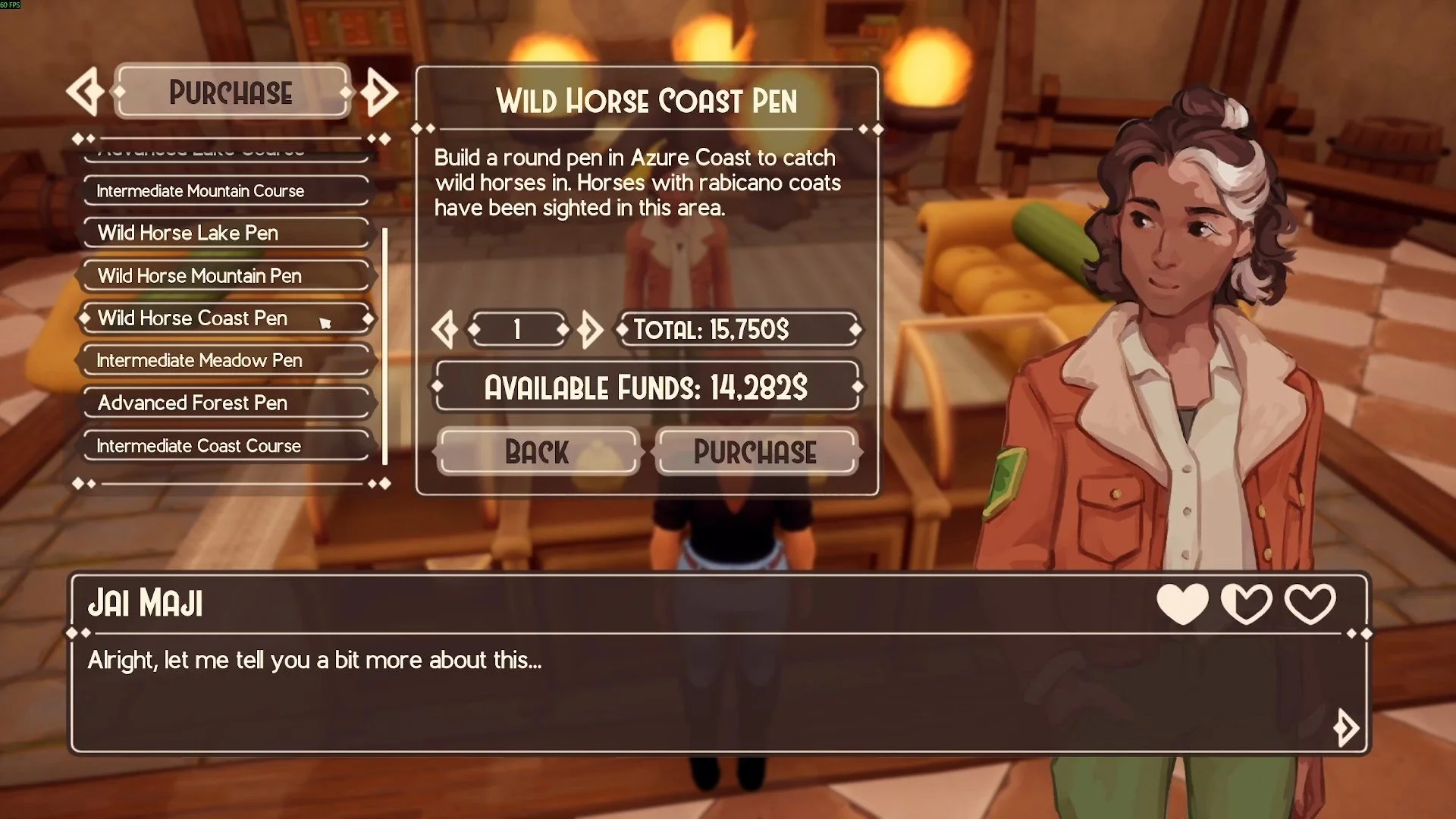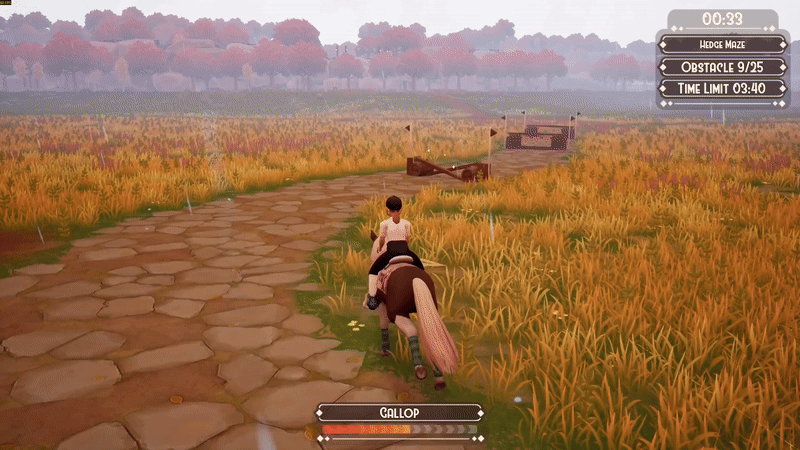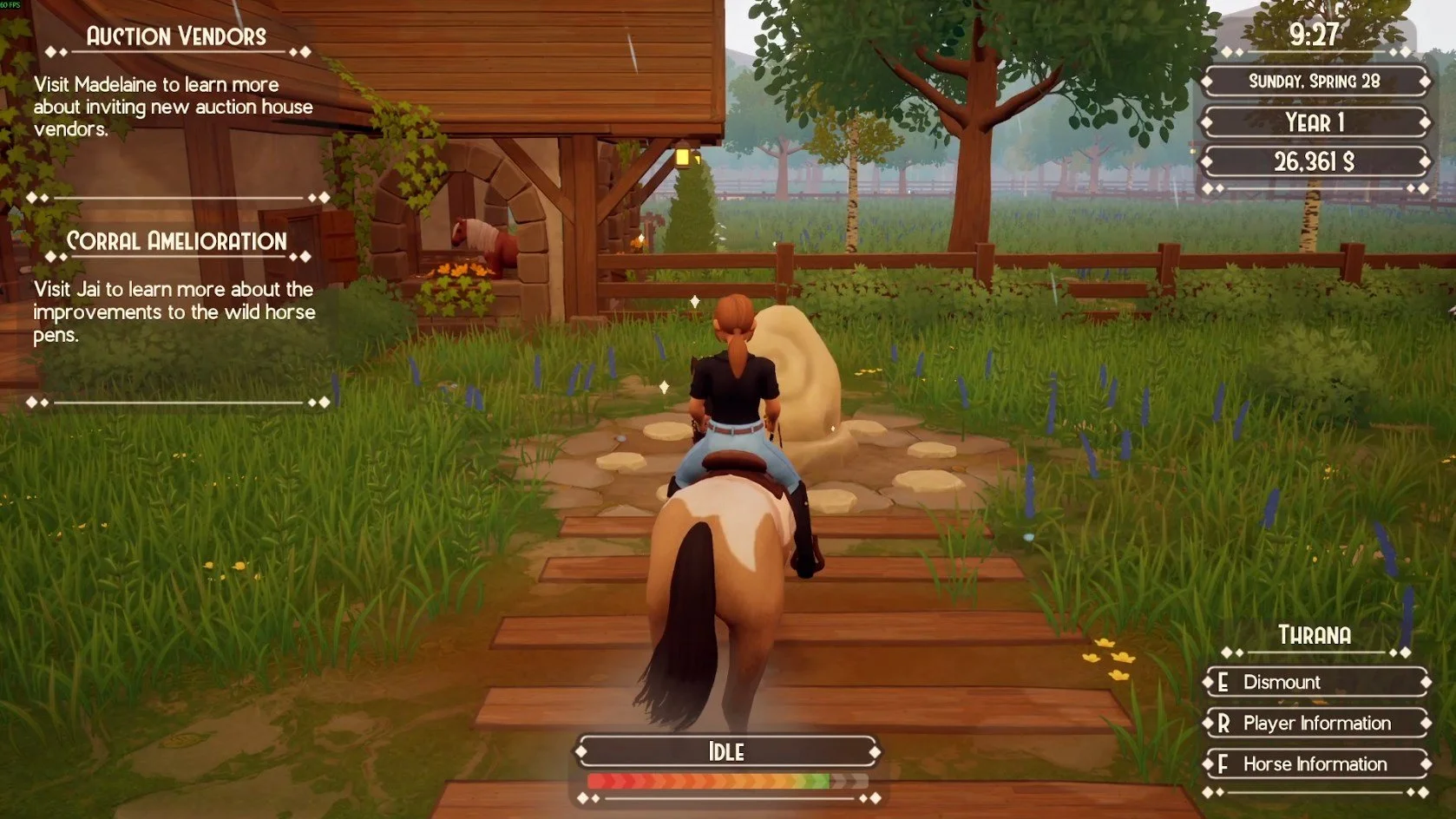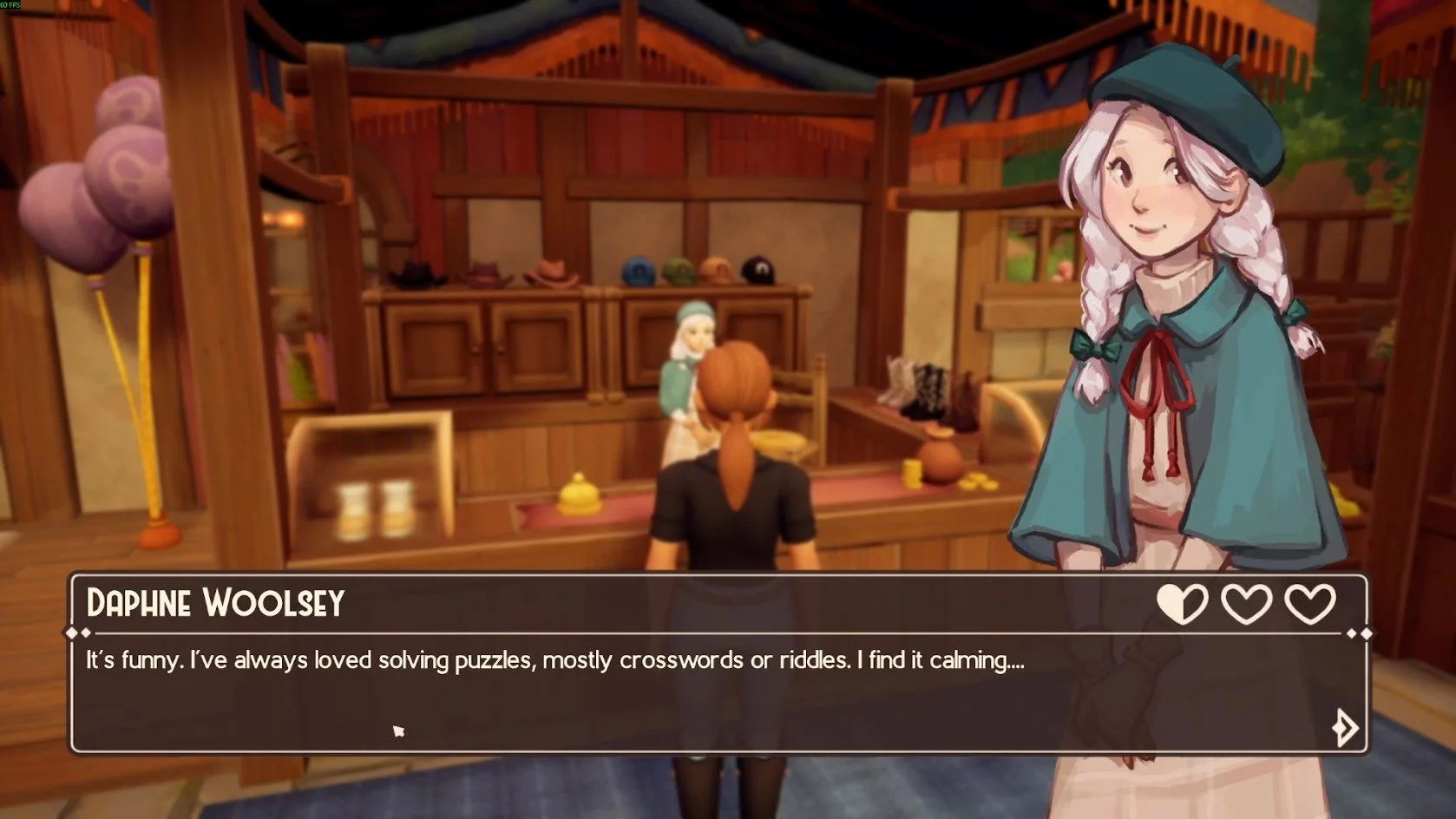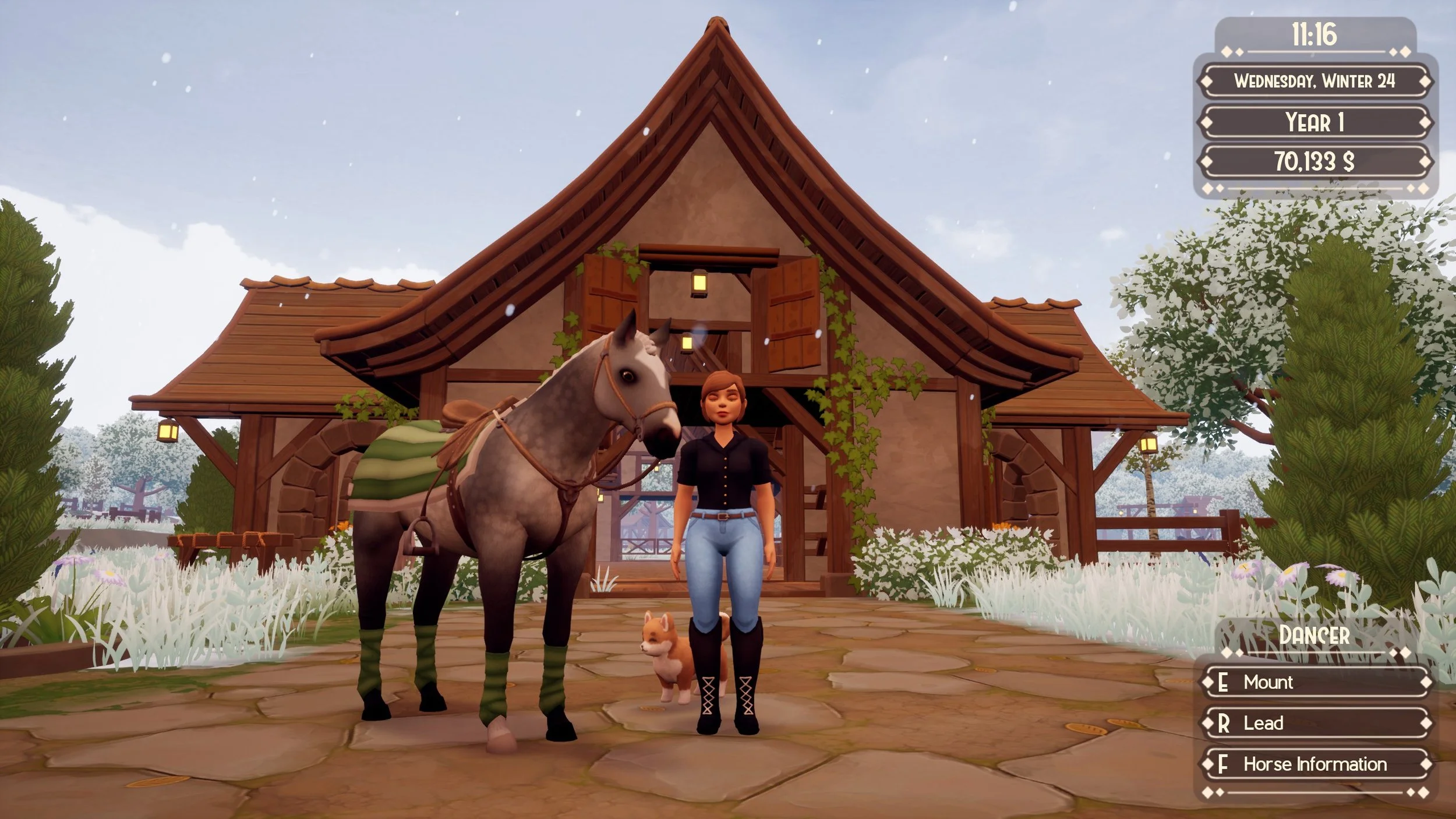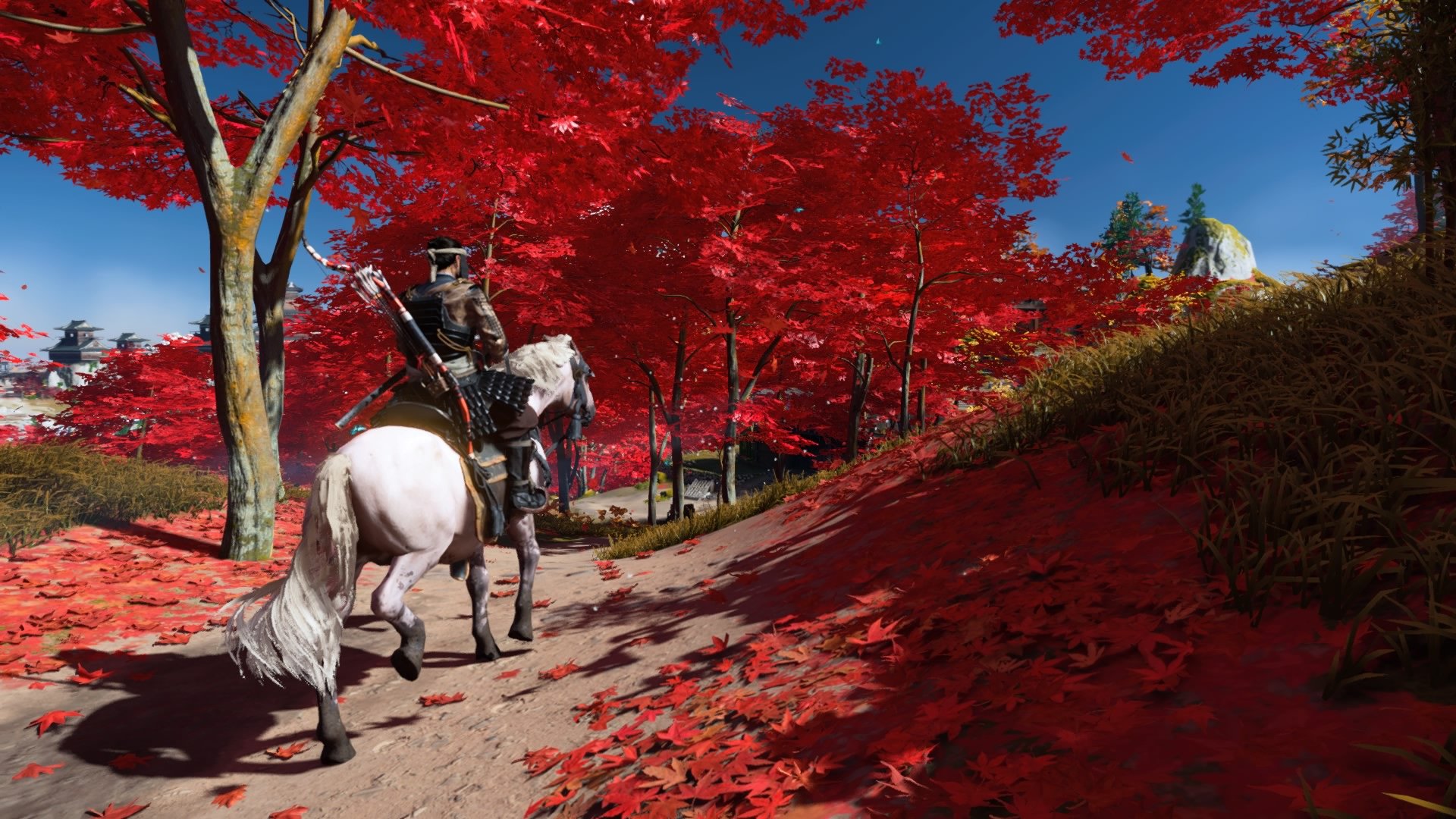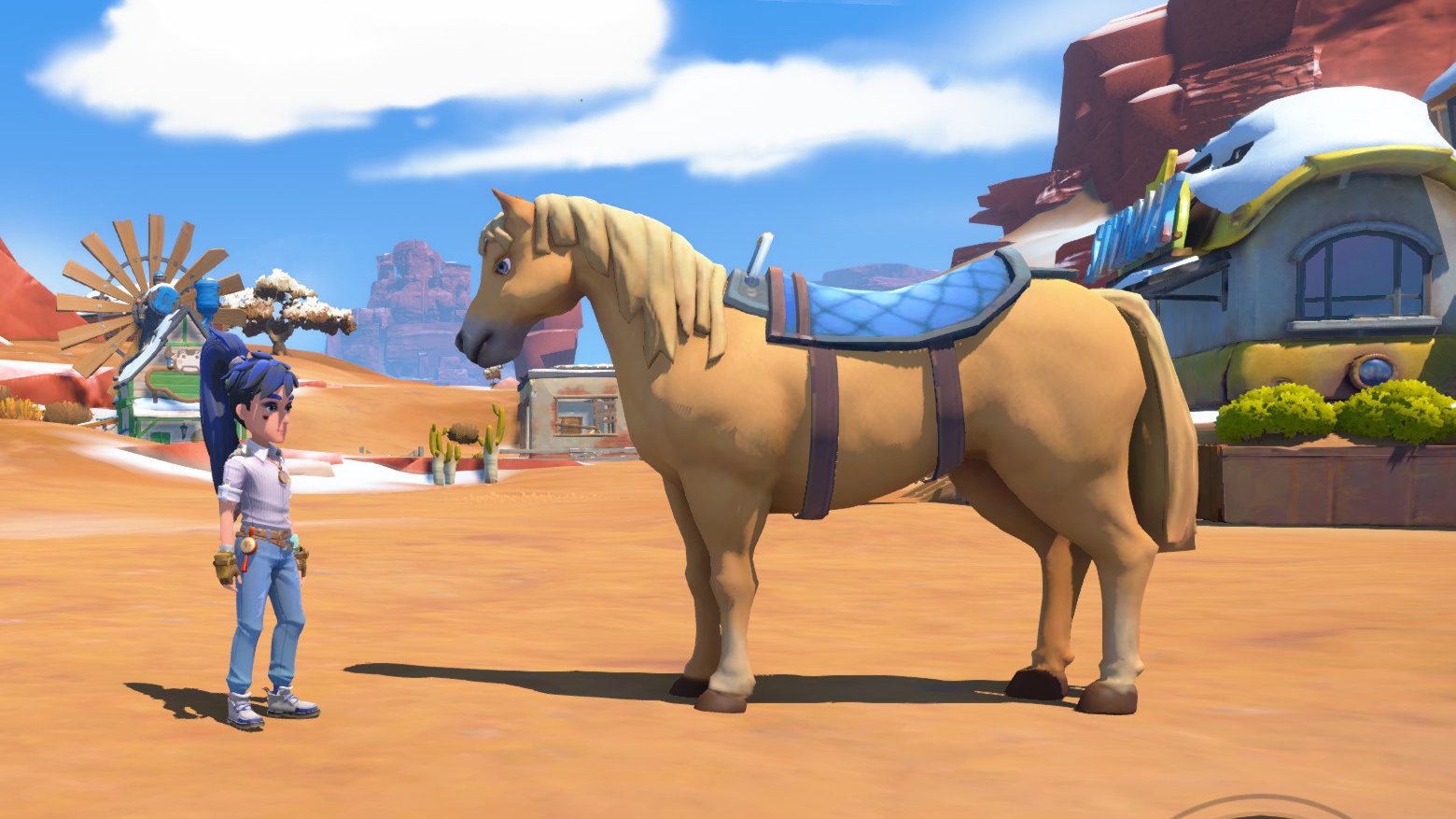Review: The Ranch of Rivershine – An Almost Perfect Horse Game and What We can Learn from it
I have written about The Ranch of Rivershine on this site on various occasions over the years, from its initial announcement, to my impressions of its first playable demo, to an in-depth interview with its creator earlier this year. What’s been missing is an actual review of the game, which I knew I only wanted to tackle once the game left Early Access and was fully released and complete. The time for that has definitely come, so let’s dive into my actual play experience with the most successful indie horse game on Steam.
Welcome to Rivershine
We don’t quite inherit a run-down farm in this one, though the premise isn’t too far off those well trodden paths. You, the player character, arrive in Rivershine in order to take up work as a groom for the new Champion rider. As it turns out however, the Champion is a no-show, so you’re gonna have to step in, get your first horse from the auction house and take over the titular Ranch to return the town of Rivershine to its former glory as a center of equestrian achievements.
Painted scenes set up the game’s premise for the player
Auction house manager Madelaine Beauchamp serves as your primary guide in the game
Villager dialogues are a helpful source of tips early on
I spent a lot of my first days just riding around watching my skills go up.
From there, and with the help of the friendly residents of Rivershine, you quickly discover the gameplay loop that makes up the Ranch of Rivershine experience: You ride around to turn your horse’s Potential into Skills and collect forage along the way, you make money by participating in cross country race competitions and selling extra forage, and you invest your earnings into upgrades to your ranch or new and better horses. As you move from early to mid game, selling forage becomes less attractive, so you instead start catching, training and selling wild horses for income, all while still slowly climbing higher on the competitive ladder using the horses you’ve bought, bred or tamed.
And you know what? All of that works really damn well. But first, let’s dig into some of the individual horsie features:
Horse Care
Horse Care in The Ranch of Rivershine isn’t necessarily special because of what you can do – being able to feed hay and grain and brush your horse isn’t a rarity in our genre – but because of how well those features interact with the rest of the gameplay: Grains and hays and treats can be bought, but for the most part you’ll find them in the open world as you explore and train your horse. Grains and hay is used to satiate your horse – not doing so leads to illness – but more importantly, different kinds of grain give your horse a bonus in learning a specific skill for that day, making the choice of feed a strategic decision rather than only a caretaking interaction.
Grain choice impacts your training for the day, see text on the right
Note that these are late game screenshots. Your first few piles of sand and wood shavings are hard to come by!
Mucking out your horses’ stalls isn’t just a chore, but rewards you with valuable manure that you can sell or craft into fertilizer once you start to grow your own feed. Collecting food items, medical herbs and bedding material out in the world is such a no-brainer of a game mechanic that I’m retroactively mad that almost no other horse game before this has incorporated such a thing into its gameplay loop.
Brushing your horses isn’t particularly exciting in Rivershine, but the basic user experience works well, and the chore becomes less time consuming later in the game once you have the money to spare for better brushes. Again, this such a simple thing to add, and yet such a huge difference in letting horse care interactions stay an enjoyable part of the gameplay instead of becoming pure tedium.
One nitpick I have with the horse care in Rivershine is that providing horses with turnout (that is, putting them into pasture) is a mechanical disadvantage for a horse in training, as it consumes valuable potential and energy. I’ve gone into more detail about why I think treating pasture time for horses as an optional inconvenience is a shitty tendency in our genre in this article. This sure doesn’t ruin Rivershine for me, but it’s a rare detail in this game that I hope future horse games don’t take close inspiration from.
Skills and Training
Training in The Ranch of Rivershine follows a learning by doing approach: Cantering trains Speed, galloping trains Endurance, riding tight turns trains Flexibility and jumping trains Jump. How high each horse's skills can be trained depends on their overall Potential, which is slowly consumed and converted into skill when training.
Early game: jumping obstacles from a trot so I train specifically only Jump and not Speed or Endurance.
Late game: using grain and an upgraded training arena in the right trail region to speed through flexibility training.
Wild-caught horses and homebred foals come with 100% Potential, but with four skills to invest into that means wanting base skills of 75% on average. What you start out with are skill values around 10%, so getting closer to a perfect horse is a long process of breeding for improvements and saving money for upgraded wild horse pens that have a chance of spawning wild horses with more advanced skills. All of this makes for a satisfying experience both in the short and long term: early on, spending a day on Speed training makes a big difference in your starter horse’s chances of getting first place in the beginner Competitions. Later on, breeding two high value horses together results in foals with enough skill and potential that they’re worth it despite the time-consuming process of raising them to adulthood.
Getting a completely maxed out horse with perfect skills took me a bit over 60 hours of playtime, though you can easily invest a lot more if you’re also breeding for specific colors rather than just (mostly) going for stats like I did.
Over the course of the game, you slowly work your way up towards perfect skill stats.
Traits give your horses different advantages, but don’t change their behavior or personality.
In addition to stats, horses also come with individual traits for Earning, Care and Training, giving them advantages in training specific skills or in specific locations, reducing the effort needed for their care, or providing additional rewards from competition or exploration. Horses that never get dirty can be a convenient timesaver, but I think I got particularly lucky getting a horse with the Harvester trait early on: this trait doubles every foraged pickup, and therefore provided a neat little boost in items as well as extra forage to sell in the early game.
Models and Animations
Rivershine’s horse models and overall graphics go for cute stylization rather than photorealism, which I personally greatly appreciate and find a much more reasonable choice for a solo developer. More importantly, the horses in The Ranch of Rivershine are stylized and simplified in a way that preserves their basic proportions and the key characteristics of what makes equine faces lovable to me. Why exactly that works is a deep dive for another day, but I’ve definitely also seen examples to the contrary.
The horse’s movement animations are admittedly something of a weak spot in what’s otherwise perhaps the most glowing review I’ve ever written on this website. The horses slide over the ground, their footsteps not properly lining up with their movement speed. Turning in place looks awkward, the faster gaits lack impulsion and proper leg extensions. The horse’s legs tend to move only from the knee and elbow down, rather than incorporating the full shoulder and haunch into the movement. All in all, many motions seem a bit stiff, and could have probably benefited from another polishing pass. (Éloise, if you want specifics, you know where to reach me!)
The legs don’t really extend properly to a full foward stretch at the trot.
The horse noticeably slides over the ground at a walk.
All gait animations have correct footfalls…
…they just tend to be a bit stiff.
All that being said, these animations work a lot better for me than any existing asset pack. Basic footfalls are correct and the most common mistakes are entirely avoided, and the animations include a lot of horsie detail that doesn’t make the cut all too often. Like how a grazing animation includes the forelegs being spread apart to the front and back, that the horse will occasionally move its ears around as if to listen, and that an idle mount will relax a hind leg. The transitions into those animations are a bit rough, but if I have to pick between these hand-made oddities and the usual awkwardness of inverse kinematics and faulty asset packs, I’ll take Rivershine animations any day.
Wild Horse Shenanigans
Let’s dive into two interesting features where Ranch of Rivershine manages to innovate, but not without its share of issues: Horse taming and lunging.
Wild horses are a somewhat rare sight in the Rivershine surroundings and show up occasionally in one trail area at a time, with each region having its own gene pool and offering horses with different coat color traits and patterns. To tame a horse, the player needs to herd it towards a corral – potentially across a large part of the region’s map – where the horses can then be inspected, and one horse can be selected as the day’s catch. Horses spawn in bands of about seven or eight, and the player can choose to either single out their favorite by looks from the start, or herd the whole bunch of them towards the coral to then pick a horse taking skill levels, gender and health status into account.
Overall, this mechanic serves its purpose of giving you another source – next to the auction house – of high potential horses that you can select for color and skill, train and then either sell or use in your breeding program.
Roach, is that you?
That herding eight wild horses into a corral by yourself across an open field isn’t easy is probably realistic, to be fair.
I also found it one of the most frustrating parts of the game however, because the wild horses’ behavior is incredibly wonky. I won’t rake a solo dev over the coals for not programming lifelike herding and fleeing behavior, mind you. Pathfinding AI is a complicated enough topic when it comes to single NPCs, let alone when multiple instances (horses) are supposed to group together and interact. Meaning: I completely get why this feature isn’t better, and it does serve its purpose. Still, horses glitching onto boulders and erratically running in directions you don’t expect them to is a noticeable aspect of jank in an otherwise very polished product.
Wild horses’ evasive behavior tends to include quite a bit of sideways sliding
Horses glitching onto each other or onto the landscape is often just a bit visually odd, but sometimes they also get stuck and can’t be caught anymore.
Once you’ve brought a horse to your stable, it’s time to get its “tameness” meter up, and the best method for that is lunging the horse in your round pen. I appreciate that feature in principle – using lunging to train foals while they’re too young to ride is also a solid choice – but the feature is just not satisfying or interesting, and its user experience is made awkward and cumbersome by the controls being on-screen buttons rather than keystrokes. While I didn’t mind a certain repetitiveness in other aspects of the gameplay – more on that below – lunging quickly became enough of a chore that I soon stopped training my foals that way beyond the bare minimum.
Lunging being controlled through button clicks makes it all feel a bit sluggish.
That you can view the lunging from different camera view points is a neat detail!
The Rivershine Economy
Money serves as the main gate to progress in Rivershine, and the ways in which you earn and spend it grow and change over the course of the game: My first few in-game days had me selling manure to afford initial upgrades, while later competitions bring more prize money and let you save up for big purchases like a Riding Hall. This isn’t particularly innovative perhaps, and I understand that some players are more than eager for cozy games that aren’t capitalism simulators. But in our horsie niche, I think this is the first time that any game really does this sort of thing well. After all, I’ve been hoping for anything Stardew-Valley-like with more of a horse focus for the better part of a decade now, and Rivershine comes closer to that than any other game I’ve played.
Riding in cross country races for prize money remains a key source of income throughout the game, with more advanced competitions yielding significantly more prize money.
Investing into wild horse pens means you’ll be able to catch horses with rarer colors and higher skill values.
Riding the same handful of race tracks – there are 24 in total, but some yield more money – managed to become comfortable routine to me rather than tedious grind, by virtue of learning shortcuts and optimizations along the way and picking up magical blessings on the track once they’ve been unlocked. And when a game like that is still fun but doesn’t require a lot of active brain power anymore, I just bridge that gap by putting on an audiobook or video essay, and that works just as well for me.
The core loop stayed satisfying even over the 65 hours of playtime it took me to finish the story. Sure, some aspects get repetitive, but there’s shortcuts to unlock at every end: At the start, trotting around in circles to slowly increase your agility feels worth it, but once you’re on your third generation foal crop you’re happy to have the resources to use performance-enhancing feed, fast-travel to the agility arena and race through the checkpoints to maximize your skill gain for the day as quickly as possible, because you probably have five other horses to take care of on that in-game day.
The challenge during competition is managing your stamina well, approaching obstacles head-on, and learning the track well enough to take minor shortcuts.
Your horses get noticeably faster and more agile as you train and improve, making later competitions quite fast-paced.
Characters, Quests and Content
I wouldn’t describe The Ranch of Rivershine as a story-driven game, and yet it has a significant amount of quest content and dialogues that guide the player through all relevant mechanics and provide a neat bit of flavor and fluff around them. The narrative content is very much centered around the player’s rise to prominence as Rivershine’s champion rather than offering much of a plot on top, but I think that’s to be expected and perfectly fine for a game in this style. I appreciated the game’s little mysteries and gradual reveals, like the glowing horse statues and eventual benefits you get from them. It all isn’t spectacular but just solidly well done and functional.
The density of available quests isn’t super high once you’ve progressed past the initial tutorialization, but there’s never any doubt as to what you “should” do next. There’s always the next competition to win or the next area to explore. I did have the occasional lull in my play experience, when new quests got a bit more sparse, but the real moment of “Okay I think I’ve seen it now” really only came once I had finished all the quests and bred a perfect horse. And even so, I am at least somewhat tempted to go back and breed some more for prettier colors.
Your quests in the top left of the screen always give you the next bigger goal apart from the daily loop or caring and training.
NPC dialogues will eventually repeat, but they have quite a bit of stuff to say before they do!
User Experience Hiccups
For the most part, The Ranch of Rivershine has a solid user experience. As outlined above, it does a good job of gradually introducing the player to features and content. The third person controls feel perhaps a bit tank-y, but writing a good third person controller is an art and a science that I’ve seen bigger teams struggle more with.
There are a few exceptions where Rivershine drops the ball though: That I have to manually toggle free-cam (instead of mouse controls) every time I start up the game even though it’s the only setting I ever play with is an unnecessary bit of friction, for example. That the horse tack customization shows all locked options from the beginning, making it incredibly tedious to check which items I already own early on is very annoying. That I cannot unequip individual accessory items in the same screen also irritated me repeatedly.
Horse customization is great in terms of options and aesthetics! But the UI is only convenient once you have the majority of options unlocked. Before that, finding what you own is incredibly tedious.
If you like taking pretty screenshots, not being able to reduce the UI elements on screen is a pain point.
For a game where 90% of gameplay happens on horseback, having to dismount for every interaction and conversation is not ideal, and I imagine that foraging was an incredibly tedious process before pets were added — in the complete version of the game, your cat or dog can fortunately collect items for you while on horseback.
There‘s a few other bits of weirdness, like how the Escape key sometimes work to exit a menu and sometimes doesn‘t, and if I had a wishlist of quality-of-life improvements I‘d also ask for an option to disable the UI entirely for taking pretty screenshots, and for a way to see my horses‘ total sum of skills and potential so I didn’t have to maintain a spreadsheet on the side to keep track of my stable‘s best competitors.
While we‘re on technicalities, I‘ll add that my experience has been largely bug-free, and the few hiccups I‘ve encountered were easy to work around.
Closing Thoughts
The Ranch of Rivershine is not a perfect game, nor will it appeal to quite everyone in search of horsie game experiences. But it is a rare and remarkably well executed game where horse-focused themes meet game dev competence. It is without doubt one of the few times I can confidently apply the label of Good Horse Game™, instead of adding a myriad of caveats to my praise.
Many of the games I‘ve played for this website, I play because I want to write about them, not so much for the intrinsic joy of playing them. The Ranch of Rivershine is probably the first time since the inception of The Mane Quest that I can legitimately say that I would have played, liked and finished this game even if I didn’t have an audience to share it with.
And as I’ve already talked about in more detail with Éloise in this interview earlier this year, I am excited and curious to see the ways in which this game’s success – from a game design perspective, but also a financial one – will inevitably shape the future of the horse game niche. I want to live in a world where The Ranch of Rivershine is the start of what Good Horse Games can look like, not the conclusion.
The Ranch of Rivershine is a wonderful example of what horse games can be when a passion for horses meets proficient game development. I wholeheartedly recommend playing it if you for some reason haven’t already, and I look forward to observing its legacy and its impact on our niche in the coming years.
The Ranch of Rivershine is available on Steam for PC. The Mane Quest has been provided with a free review key.


